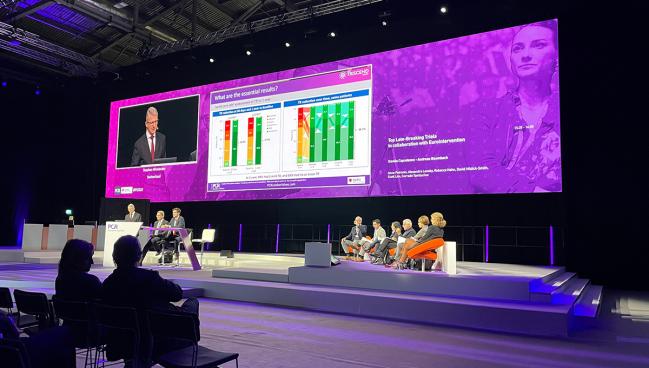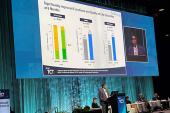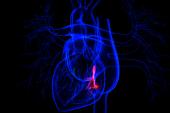Big Gains in Function, QoL With Transcatheter TV Replacement: TRISCEND Registry
The pivotal TR trial of Evoque, now enrolling, will clarify just how well patients do with valve replacement vs pills alone.

LONDON, England—Patients with symptomatic functional or degenerative tricuspid regurgitation (TR) treated with transcatheter tricuspid valve replacement in the global TRISCEND registry show high rates of survival and freedom from heart failure hospitalization as well as significant and sustained TR reduction at 1 year, according to new results released here at London Valves 2022.
Even more striking, said Stephan Windecker, MD (Bern University Hospital, Switzerland), who presented the results during Sunday’s late-breaking clinical trial session, the vast majority of patients also demonstrated clinically meaningful gains in functional and quality-of-life outcomes.
A randomized clinical trial of the Evoque device (Edwards Lifesciences) is already underway, hopefully paving the way for regulatory approval—it has not been cleared for use in any country to date. Asked about the pivotal trial after his presentation, Windecker said he could not disclose how many of the 840 patients have been enrolled so far.
For now, however, “I think you all can already speculate about the outcome,” he said. “What is particularly interesting is the symptomatic outcome: if you look at the KCCQ-score improvement, which was 55% above 20, and then 22% above 10, these are very large, clinically meaningful differences. In other words, the patients were, before the intervention, in fair or poor condition, and after the intervention they had large or very large treatment effects.”
Tricuspid regurgitation is far from rare, Windecker reminded the audience, calling it “prevalent and undertreated.” TRISCEND co-investigator Susheel Kodali, MD (NewYork-Presbyterian/Columbia University Irving Medical Center, New York, NY), has previously put the number of people in the United States with TR at 2.4 million. Surgical interventions are infrequent, though, with just 10,000 done per year, and medical options are few.
TRISCEND at 1 Year
TRISCEND is a global, prospective, multicenter trial enrolling patients with moderate or greater tricuspid regurgitation, with signs and/or symptoms or prior heart failure hospitalizations due to TR despite optimal medical therapy. The Evoque device itself is delivered transfemorally via a 28-Fr sheath and is secured in place using “atraumatic anchors” that engage the leaflets, chords, and annulus, Windecker noted.
One-year results for 176 patients (mean age 78 years; 71% female) enrolled at centers across North America and Western Europe are largely in keeping with the earlier report from the TRISCEND investigators.
The patients were, before the intervention, in fair or poor condition, and after the intervention they had large or very large treatment effects. Stephan Windecker
As Kodali’s earlier snapshot revealed, implant success is high in this series, at 96.2%. Procedures are relatively quick (a mean of 72 minutes from implant insertion to release) and length of stays are a median of 3 days, with the majority (91%) of patients being discharged home.
At 12 months, core lab-adjudicated cardiovascular mortality was 9.4%. There were no myocardial infarctions and strokes were rare, occurring in just two patients. Kaplan-Meier estimates of survival and freedom from heart failure hospitalizations were 90% and 88%, respectively, Windecker said.
Nonelective tricuspid valve reinterventions occurred in six patients, and severe bleeds occurred in more than one in four patients.
A ‘Typical’ Early-Stage Trial Population
Discussing the registry findings with TCTMD, Davide Capodanno, MD, PhD (University of Catania, Italy), pointed out that the patients in TRISCEND are relatively high risk: elderly, with a mean STS score of 10. Fully 75% had pulmonary hypertension, and 92% had atrial fibrillation. While that kind of patient mix is “typical” of early-stage intervention trials, he said, it does point to a frail cohort, most of whom would be taking anticoagulation for their AF, which likely explains the high rate of bleeding.
New pacemakers were required in 13.3% of patients, roughly half of which were for atrioventricular block, Windecker noted.
This is the investigators doing their homework. Davide Capodanno
Queried during the Q&A about how the device and its anchors might contribute to conduction disturbances, Windecker said that patients with preexisting left bundle branch block or biventricular block do need to be screened for very carefully, but that given the heart failure burden in this population, baseline pacemaker use is typically quite high. One-third of patients in this study had a preexisting pacer, he noted.
Conduction disturbances are “an important consideration,” said Windecker. “But overall, I think it's not an overly concerning issue.”
Towards the end of his presentation, Windecker highlighted the extent of TR reduction at 1 year as compared with 30 days, demonstrating the marked stability of the early gains. While roughly 40% of patients had torrential or massive TR at baseline, by 12 months 97.6% had none, trace, or mild regurgitation.
Likewise, echo core lab results showed stable improvements in hemodynamics which tracked with progress in functional gains. While just 26% of patients were in NYHA class I or II at baseline, by 1 year that proportion had risen to 93%. Mean KCCQ overall summary score rose from 46 to 71.7, and 6-minute walk test improved by 56 meters.
“What we do know is that improvements in KCCQ score also correlate with clinical outcomes,” Windecker said. “One paramount example is, for example, the PARTNER B population undergoing TAVI that had a similar degree of KCCQ improvement [at 1 year]. So this gives you some reason to speculate how the clinical outcome might be in the future.”
More Info to Come
Speaking with TCTMD, Capodanno resisted the urge to speculate, calling TRISCEND a “good snapshot of the technology” at this early stage, particularly since the outcomes were all core lab adjudicated.
“This is a good picture of a typical high-risk population with TR,” he said. “You need to see this before you progress to seeing something more exciting. This is the investigators doing their homework.”
Evoque is just one of “many” devices trying to make headway in the tricuspid space, with full replacement being joined by other percutaneous devices including clips and rings, said Capodanno.
Shelley Wood was the Editor-in-Chief of TCTMD and the Editorial Director at the Cardiovascular Research Foundation (CRF) from October 2015…
Read Full BioSources
Windecker S. TRISCEND study one-year outcomes: transfemoral transcatheter tricuspid valve replacement. Presented at: PCR London Valves. November 28, 2022. London, England.
Disclosures
- Windecker reports receiving research, travel or educational grants to his institution from Abbott, Abiomed, Amgen, Astra Zeneca, Bayer, Biotronik, Boehringer Ingelheim, Boston Scientific, Bristol Myers Squibb, Cardinal Health, CardioValve, Corflow Therapeutics, CSL Behring, Daiichi Sankyo, Edwards Lifesciences, Guerbet, InfraRedx, Janssen-Cilag, Johnson & Johnson, Medicure, Medtronic, Merck Sharp & Dohm, Miracor Medical, Novartis, Novo Nordisk, Organon, OrPha Suisse, Pfizer, Polares, Regeneron, SanofiAventis, Servier, Sinomed, Terumo, Vifor, V-Wave; serving as advisory board member and/or member of the steering/executive group for trials funded by Abbott, Abiomed, Amgen, Astra Zeneca, Bayer, Boston Scientific, Biotronik, Bristol Myers Squibb, Edwards Lifesciences, Janssen, MedAlliance, Medtronic, Novartis, Polares, Recardio, Sinomed, Terumo, V-Wave and Xeltis with payments to the institution but no personal payments.
- Capodanno reports no relevant conflicts of interest.




Comments